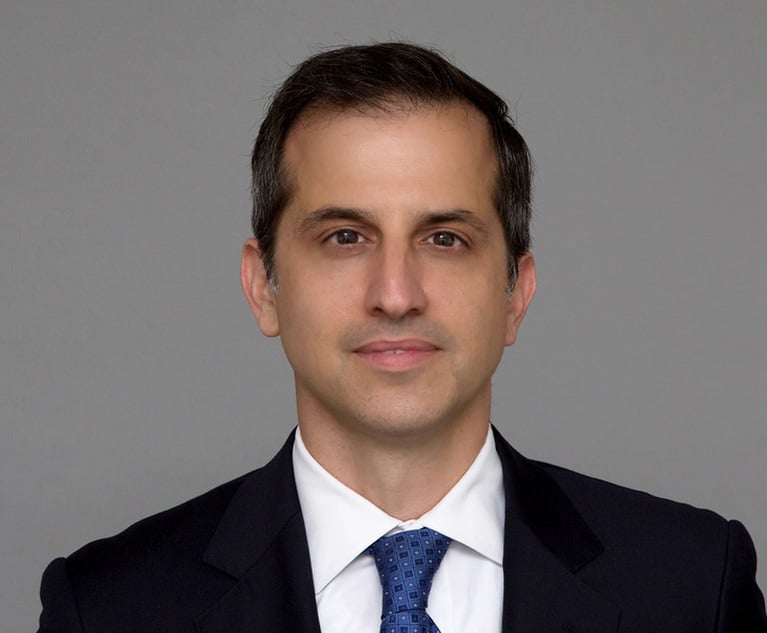In Monthslong Med Mal Trial, Allegations of a Doctor-Led Cover-Up—and a $60M Verdict
Patricia Jones, of Pomona, New York, and her husband, John, were awarded a total of $55.9 million by a Rockland County jury in what many believe is the largest medical malpractice verdict amount in county history.
August 20, 2019 at 06:19 PM
11 minute read
The original version of this story was published on New York Law Journal
 Evan Torgan of Torgan Cooper + Aaron in New York/courtesy photo
Evan Torgan of Torgan Cooper + Aaron in New York/courtesy photo
It was 2011, about two years after lawyer Evan Torgan’s client was paralyzed from the neck down because of what happened during neurosurgery, when the manila envelope arrived.
Torgan, who still hadn’t launched a lawsuit, had been trying to collect all the medical records linked to the surgery that he could—first asking his clients to try to get them, without his involvement, so as not to tip off potential defendants. Then he began talking to the neurosurgeons who performed the operation, in an effort to come up with still-missing records.
And so when he ripped open the envelope, he was shocked, he recalls today. Despite the lead surgeon’s operation report stating that “no adverse events were recorded,” he was staring at an image from spinal cord-signal monitoring set up during the surgery that he said clearly showed “every single muscle group on the right side [of his client’s] body had suddenly flatlined,” meaning that half of her body had stopped receiving signals from her spinal cord.
“Why wasn’t that in the operation report?” Torgan said almost aloud to himself, he remembers.
He jumped up and ran to his partner’s office. “You gotta see this!” he yelled.
“Up until that point, I wasn’t sure that we had a case, until I opened that envelope and I saw the screenshots showing the evoked potentials”—or monitored spinal-cord signals—“went down. And the key was that they [the neurosurgeons] hadn’t told anyone about it,” Torgan of Torgan Cooper + Aaron said in an interview. “It was unbelievable.”
Earlier this month, about eight years after his 2011 discovery, Torgan’s client, Patricia Jones of Pomona, New York, and her husband, John, were awarded a total of $55.9 million by a Rockland County jury in what is believed to be the largest medical malpractice verdict amount in county history.
 Patricia and John Jones (courtesy photo)
Patricia and John Jones (courtesy photo)At the close of a five-month trial, six jurors found that the lead surgeon from the 2009 operation, Dr. George Alexander Jones, and assisting surgeon Dr. Daniel Spitzer, had not followed the proper standard of medical care when they performed a procedure on Patricia Jones called a laminectomy. Several nurses also were found to have contributed to Patricia Jones’ injuries, but they settled their cases during the trial.
The procedure itself is known as a fairly routine spinal operation, and it was aimed at alleviating pressure on Patricia Jones’ spinal cord, Torgan said. Patricia Jones had been looking for relief, a way out, from disturbing and growing tingling in her hands and neck, and from neck pain, he said.
Some members of the jury, which deliberated for nearly five days, reportedly found that a cover-up of sorts by the surgeons had happened through a lack of crucial information in their operation reports and notes, according to Torgan, who interviewed the jurors after they delivered the verdict. They reportedly told the medical malpractice attorney that they’d believed the plaintiffs’ argument that doctors had left out alarming surgery events, and that the doctors hadn’t relayed all of what occurred during the operation to certain physicians and nurses who treated Patricia Jones in the hours afterward.
The defendants, for their part, had contended that Jones sustained the spinal injury after, not during, the procedure, and denied allegations of a cover-up.
At the state Supreme Court trial in New City, the image from the monitoring that Torgan had diligently uncovered in 2011 had been blown up into a huge poster-board placed right in front of the jury’s eyes, Torgan recalled in a recent interview.
In his telling and recollection, it had major impact.
“There was the board that showed every single muscle group flatlined on the right side of her body,” he said, and the jurors “looked absolutely shocked that there would be a flatline like that without information [about it] later going to a team in the hospital” that cared for her.
“We were lucky that the secretary [to the neurosurgeons] sent it to us” in 2011, Torgan said of the imaging. ”We never thought that they [the surgeons] would be less than truthful about saying the evoked potentials were normal throughout.”
On a Friday afternoon, the jury gave Patricia Jones, now age 66 and a quadriplegic, $20 million for pain and suffering, many millions more for future medical care and related costs, and some other amounts for lost earnings, home cleanings and other needs.
Her 67-year-old husband John was awarded $10 million for loss of consortium.
In the trial’s extensive verdict sheet, the jury also apportioned fault among the medical professionals who handled the 2009 laminectomy. It reasoned that Jones and Spitzer (the brother of former New York State Gov. Eliot Spitzer) each were 25% at fault, while two nurses who settled their cases shared in the fault (5% and 15%, respectively); and that a nurse practitioner who also settled was 30% responsible.
Another surgeon involved in the operation, Dr. Jeffrey Degen, who monitored the spinal-cord signals from an office, was found not to be at fault, according to the verdict sheet.
Meanwhile, noted Torgan, the $55.9 million total amount awarded to the Joneses will be reduced by 50%, under state law, because of the 50% responsibility of the nonsurgeon parties who settled.
In addition, he said, Drs. Jones and Spitzer, through their defense attorney, Carl Weinberg of Schiavetti, Corgan, DiEdwards, Weinberg & Nicholson in White Plains, have made a motion to set aside the verdict to trial Judge Rolf Thorsen. And they’ve said that they intend to appeal any remaining verdict to the Appellate Division, according to Torgan.
Weinberg could not be reached for comment despite multiple attempts.
Nevertheless, the Aug. 2 verdict has been a major and important achievement for Patricia Jones and her husband, Torgan said—one that they felt was a long time coming.
John Jones, after the verdict, told the lawyer in sincere tones that the verdict was “really just the recognition that they [the surgeons] had done this to his wife, and that meant so much to him,” said Torgan.
Patricia Jones—who today mostly cannot use her arms and who can’t feed herself, and who was too ill to be present in the courtroom for the verdict—called the attorney later and “just thanked me for believing in her and showing everyone what happened,” he recalled.
The eight-year litigation and long trial hinged on what happened both during the operation and in the day or so afterward, according to Torgan and court records, including opening arguments laid out in a trial transcript.
Torgan told the six jurors in his opening statement, “There’s no question about it—during the surgery the spinal cord monitoring dropped out, showing there was some kind of injury to the cord.”
Then, he added, “And there’s no question about this either: They [Drs. Jones and Spitzer] didn’t put it in the hospital record. They didn’t put it in the operative report. They didn’t tell one soul that that occurred outside of the operating room suite,” and, “Through no fault of her own, no fault of her own, Patricia Jones has suffered injuries that have changed her life; injuries that will remain with her for the rest of her life; and perhaps just as importantly, injuries that will continue to affect her life.”
But the following day last April, Carl Weinberg, the defense lawyer, countered a number of Torgan’s opening arguments point by point, prompting the plaintiffs lawyer to rise up repeatedly and object to the judge about Weinberg allegedly characterizing his opening arguments incorrectly, the trial transcript shows.
Weinberg was undeterred. And one of his and his clients’ central arguments throughout the case and trial was that during the day after the operation, Patricia Jones suffered a spinal infarction, or stroke, sadly, and that that was the cause of her paralysis. It was not caused, he said, by what the plaintiffs contended: That a neck-bone fracture happened during the laminectomy that caused a contusion to the spinal cord in combination with pooling blood at the spinal cord during surgery, or a hematoma.
In Weinberg’s telling, the stroke that happened after the procedure was a terrible occurrence, but it was not anyone’s fault.
“The fact of the matter is Mrs. Jones sustained a spinal cord infarction and there was nothing that could have been done about it,” he told the jurors during his opening statement. Later, he said that “for Mr. and Mrs. Jones, I’m sure this was a terrible, terrible event, a tragic result” but that “our difference of opinion is whether or not it was the fault of anybody.”
In addition, he countered the allegations of a cover-up—as alleged by the plaintiffs pointing to reports that didn’t say anything about the spinal-cord signals “dropping out” for a period—by saying that they were actually false positives.
Weinberg added during his opening statements, “Mr. Torgan told you [Dr.] Degen doesn’t tell anybody. He doesn’t say a word [about the spinal-cord signals stopping]. This is all a big secret. Hudson Valley Neurosurgical Associates’ big secret, the MEP’s went down.
“So, you know what they did to reserve this secret, cover up the fact that the MEP’s had dropped out?,” the attorney continued in court. “Two of the principal conspirators, Dr. Degen and Dr. Huang, go back to the office and write a report about the surgery and about the monitoring in which they say quite clearly that, ‘Approximately five to ten minutes following the laminectomies, the right first dorsal interosseous, the tibialis anterior and abductor hallucis MEP’s dropped out. The operating surgeon was informed and acknowledged these changes. About ten minutes later the motor evoked potentials from abductor hallucis and tibialis anterior gradually returned, though not the First Dorsal Interosseous.”
At this point at trial, Torgan objected, but Weinberg said that he was reading from office records for the Hudson Valley physician’s group’s office, not from hospital records.
In the end, several of the jurors, according to Torgan, did believe there was a cover-up by the principal surgeons. For his part, he said, he was appalled.
Jones and Spitzer “were litigating medical malpractice as they operated,” the longtime practitioner and trial lawyer told the Law Journal.
He said that, in fact, the operation report was not even written until Patricia Jones was found slumped over and suddenly paralyzed at the hospital, about a day after the operation.
In Torgan’s view, the report was delayed in being written, “and then in the operative report, they actually said that these evoked potentials were totally normal, and they took it further, and said that there were no adverse events.”
Then, he argued, both in his telling to the Law Journal and to the jury, that the two surgeons failed to warn the after-surgery care team of what had happened during the operation.
“She’s been in a wheelchair since August 2009 because they didn’t want to tell anyone what happened in the OR,” he told the jurors at trial.
This content has been archived. It is available through our partners, LexisNexis® and Bloomberg Law.
To view this content, please continue to their sites.
Not a Lexis Subscriber?
Subscribe Now
Not a Bloomberg Law Subscriber?
Subscribe Now
NOT FOR REPRINT
© 2025 ALM Global, LLC, All Rights Reserved. Request academic re-use from www.copyright.com. All other uses, submit a request to [email protected]. For more information visit Asset & Logo Licensing.
You Might Like
View All
2024 Marked Growth On Top of Growth for Law Firm Litigation Practices. Is a Cooldown in the Offing for 2025?

Big Company Insiders See Technology-Related Disputes Teed Up for 2025

Litigation Leaders: Jason Leckerman of Ballard Spahr on Growing the Department by a Third Via Merger with Lane Powell
Trending Stories
- 1Courts Grapple With The Corporate Transparency Act
- 2FTC Chair Lina Khan Sues John Deere Over 'Right to Repair,' Infuriates Successor
- 3‘Facebook’s Descent Into Toxic Masculinity’ Prompts Stanford Professor to Drop Meta as Client
- 4Pa. Superior Court: Sorority's Interview Notes Not Shielded From Discovery in Lawsuit Over Student's Death
- 5Kraken’s Chief Legal Officer Exits, Eyes Role in Trump Administration
Who Got The Work
J. Brugh Lower of Gibbons has entered an appearance for industrial equipment supplier Devco Corporation in a pending trademark infringement lawsuit. The suit, accusing the defendant of selling knock-off Graco products, was filed Dec. 18 in New Jersey District Court by Rivkin Radler on behalf of Graco Inc. and Graco Minnesota. The case, assigned to U.S. District Judge Zahid N. Quraishi, is 3:24-cv-11294, Graco Inc. et al v. Devco Corporation.
Who Got The Work
Rebecca Maller-Stein and Kent A. Yalowitz of Arnold & Porter Kaye Scholer have entered their appearances for Hanaco Venture Capital and its executives, Lior Prosor and David Frankel, in a pending securities lawsuit. The action, filed on Dec. 24 in New York Southern District Court by Zell, Aron & Co. on behalf of Goldeneye Advisors, accuses the defendants of negligently and fraudulently managing the plaintiff's $1 million investment. The case, assigned to U.S. District Judge Vernon S. Broderick, is 1:24-cv-09918, Goldeneye Advisors, LLC v. Hanaco Venture Capital, Ltd. et al.
Who Got The Work
Attorneys from A&O Shearman has stepped in as defense counsel for Toronto-Dominion Bank and other defendants in a pending securities class action. The suit, filed Dec. 11 in New York Southern District Court by Bleichmar Fonti & Auld, accuses the defendants of concealing the bank's 'pervasive' deficiencies in regards to its compliance with the Bank Secrecy Act and the quality of its anti-money laundering controls. The case, assigned to U.S. District Judge Arun Subramanian, is 1:24-cv-09445, Gonzalez v. The Toronto-Dominion Bank et al.
Who Got The Work
Crown Castle International, a Pennsylvania company providing shared communications infrastructure, has turned to Luke D. Wolf of Gordon Rees Scully Mansukhani to fend off a pending breach-of-contract lawsuit. The court action, filed Nov. 25 in Michigan Eastern District Court by Hooper Hathaway PC on behalf of The Town Residences LLC, accuses Crown Castle of failing to transfer approximately $30,000 in utility payments from T-Mobile in breach of a roof-top lease and assignment agreement. The case, assigned to U.S. District Judge Susan K. Declercq, is 2:24-cv-13131, The Town Residences LLC v. T-Mobile US, Inc. et al.
Who Got The Work
Wilfred P. Coronato and Daniel M. Schwartz of McCarter & English have stepped in as defense counsel to Electrolux Home Products Inc. in a pending product liability lawsuit. The court action, filed Nov. 26 in New York Eastern District Court by Poulos Lopiccolo PC and Nagel Rice LLP on behalf of David Stern, alleges that the defendant's refrigerators’ drawers and shelving repeatedly break and fall apart within months after purchase. The case, assigned to U.S. District Judge Joan M. Azrack, is 2:24-cv-08204, Stern v. Electrolux Home Products, Inc.
Featured Firms
Law Offices of Gary Martin Hays & Associates, P.C.
(470) 294-1674
Law Offices of Mark E. Salomone
(857) 444-6468
Smith & Hassler
(713) 739-1250







